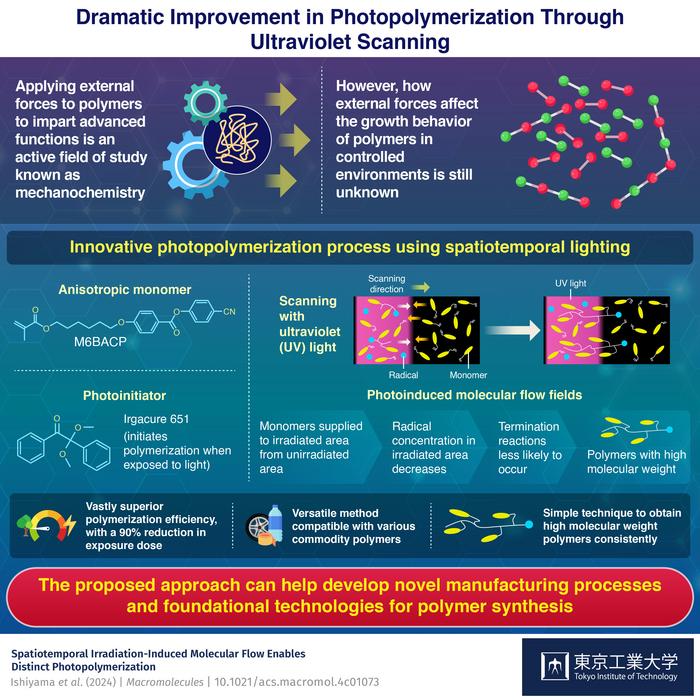Polymers are materials made out of long, repeating chains of molecules, and it is the interaction between these chains that dictate most of a polymer’s physicochemical properties. In accordance with this intuitive understanding of polymers, which dates back to the 1930s, external forces acting on polymers are mainly regarded as destructive. For example, stretching a polymer can disentangle or break apart some of its constituent chains, weakening the overall material.

Credit: Tokyo Institute of Technology
Polymers are materials made out of long, repeating chains of molecules, and it is the interaction between these chains that dictate most of a polymer’s physicochemical properties. In accordance with this intuitive understanding of polymers, which dates back to the 1930s, external forces acting on polymers are mainly regarded as destructive. For example, stretching a polymer can disentangle or break apart some of its constituent chains, weakening the overall material.
Over the past few decades, however, scientists demonstrated again and again that external forces can have constructive effects on polymers. Mechanical forces and flow fields, if leveraged appropriately, have been shown to impart new functionalities in certain polymers by altering their phase, optical properties, and crystallinity. Despite substantial progress in this field—known as mechanochemistry—not much is known about how external forces can affect the growth behavior of polymers under external forces.
Fortunately, a research team led by Professor Atsushi Shishido from Tokyo Institute of Technology, Japan, set out to shed light on this topic. In a study published in Macromolecules on July 29, 2024, they investigated how flow fields induced by dynamic UV lighting can influence the process of photopolymerization, showcasing an interesting and versatile technique to control polymer synthesis.
The photopolymerization reaction in question involved M6BACP as a monomer (the building block for the final polymer) and Irgacure 651, which is a photoinitiator. This last compound absorbs UV light and breaks down into reactive free radicals, which interact with the monomers and cause them to link together. But unlike typical photopolymerization processes, in which the entire solution is irradiated uniformly with UV light, the researchers shone UV light through a slowly moving slit instead.
Interestingly, this simple strategy had a profound effect on the resulting polymers, which the researchers demonstrated through various comparative experiments. “Photopolymerization with scanning UV light exhibited high molecular weight polymers, with a reduction of 90% of the required exposure dose compared to photopolymerization with static uniform light,” highlights Shishido.
The researchers theorize that UV light induces molecular flows with two notable effects. On the one hand, it causes growing polymers to diffuse slightly towards the yet-unirradiated area, as their concentration there is lower. This allows them to keep growing as radicals become available. On the other hand, radicals and monomers also diffuse, with the former being supplied to the unirradiated area and the latter to the irradiated area. As a result of this mutual diffusion, the radical-to-monomer concentration tends to become lower in irradiated areas, which minimizes the probability of termination reactions from taking place and putting a cap on how long a polymer chain can grow.
Overall, this study not only provides important insights into photopolymerization reactions, but also showcases a convenient way of improving existing industrial processes and polymeric materials. “The developed method significantly improves polymerization efficiency with a simple procedure of adding movement to the irradiation light, without changing existing compounds or reaction systems. This can reduce the energy cost of photopolymerization, which is used in various industrial applications, and is expected to be applied to manufacturing processes and foundational technologies for polymer synthesis,” explains Shishido. Worth noting, the observed advantages were found not only for M6BACP, but also for various commodity polymers, such as acrylates.
With any luck, these findings will pave the way to more sustainable ways to manufacture even better polymers.
###
About Tokyo Institute of Technology
Tokyo Tech stands at the forefront of research and higher education as the leading university for science and technology in Japan. Tokyo Tech researchers excel in fields ranging from materials science to biology, computer science, and physics. Founded in 1881, Tokyo Tech hosts over 10,000 undergraduate and graduate students per year, who develop into scientific leaders and some of the most sought-after engineers in industry. Embodying the Japanese philosophy of “monotsukuri,” meaning “technical ingenuity and innovation,” the Tokyo Tech community strives to contribute to society through high-impact research.
Institute of Science Tokyo (Science Tokyo) will be established on October 1, 2024, following the merger between Tokyo Medical and Dental University (TMDU) and Tokyo Institute of Technology (Tokyo Tech), with the mission of “Advancing science and human wellbeing to create value for and with society.”
Journal
Macromolecules
Method of Research
Experimental study
Subject of Research
Not applicable
Article Title
Spatiotemporal Irradiation-Induced Molecular Flow Enables Distinct Photopolymerization
Article Publication Date
29-Jul-2024



